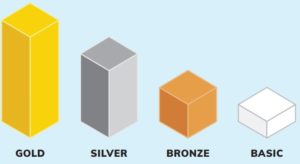Private Health Insurance Fund Reforms from 1 April
From 1 April 2019, all private health insurance funds will begin to introduce four (4) new policy levels for hospital cover, which include:

The reforms are intended to make private health insurance simpler and insurers will have until April 2020 to introduce this reform.
The level assigned to your policy will be determined according to the level of cover provided to you, and policies will cover up to 38 clinical categories. The categories are types of hospital treatments described in a standard way and each level of cover has minimum requirements of clinical categories that it must include.
How do these reforms affect plastic and reconstructive surgery procedures?
Medicare item numbers for plastic and reconstructive surgery will require specific levels of cover – some only require Bronze however, many others require Silver or Gold.
We have outlined some clinical categories below and what level of cover you may require from your health fund.
Please note this is for medically-necessary procedures only. Any procedures deemed purely ‘cosmetic’ due to not meeting Medicare’s strict eligibility criteria, would not be covered by your health fund – regardless of your level of cover.
Bronze or higher
- Bone, joint and muscle – treatment for the investigation and treatment of diseases, disorders and injuries of the musculoskeletal system.
Examples include carpal tunnel, fractures, hand surgery, joint fusion, bone spurs and osteomyelitis. - Brain and Nervous System – treatment for the investigation and treatment of the brain, brain-related conditions, spinal cord and peripheral nervous system.
Example includes peripheral nerve repair. - Breast Surgery – treatment for the investigation and treatment of breast disorders and associated lymph nodes, and reconstruction and/or reduction following breast surgery or a preventative mastectomy.
Examples include breast lesions, breast tumours, asymmetry due to breast cancer surgery or developmental abnormality, breast reduction, breast lift, breast implant removal and gynaecomastia. - Gynaecology – treatment for the investigation and treatment of the female reproductive system.
Example includes medically-necessary labiaplasty. - Joint reconstructions – treatment for surgery for joint reconstructions.
Examples include torn tendons, rotator cuff tears and damaged ligaments. - Skin – treatment for the investigation and treatment of skin, skin-related conditions and nails. The removal of foreign bodies is also included. This category does not include removal of excess skin due to weight loss – see Weight Loss Surgery.
Examples include melanoma, minor wound repair and abscesses.
Silver or higher
- Plastic and Reconstructive Surgery – treatment which is medically necessary for the investigation and treatment of any physical deformity, whether acquired as a result of illness or accident, or congenital. This category does not include skin-related conditions – see Skin.
Examples include angioma, burns requiring a graft, microvascular repair, eyebrow elevation, lower or upper eyelid reduction, face lift, lipectomy, liposuction otoplasty for minors and rhinoplasty.
Gold
- Weight Loss Surgery – treatment for surgery that is designed to reduce a person’s weight, remove excess skin due to weight loss and reversal of a bariatric procedure.
Example includes lipectomy/radical abdominoplasty.
How will I know if my surgery will be covered under my private health insurance?
Once you have met with your Specialist Plastic Surgery and discussed the surgical options available to you, we will provide you with a detailed surgical fee estimate. If a Medicare item number applies to your procedure, we will advise you however, it will be your responsibility to check with your health fund to ensure your policy will cover the item number.
Additional Information
Click here to view more information on the reforms.
Click here to view the clinical categories that will be adopted by all health funds and the hospital treatments included in each category.











